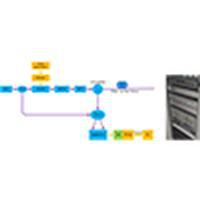当前位置:
X-MOL 学术
›
Opt. Express
›
论文详情
Our official English website, www.x-mol.net, welcomes your
feedback! (Note: you will need to create a separate account there.)
Fiber distributed acoustic sensing using convolutional long short-term memory network: a field test on high-speed railway intrusion detection.
Optics Express ( IF 3.2 ) Pub Date : 2020-02-03 , DOI: 10.1364/oe.28.002925 Zhongqi Li , Jianwei Zhang , Maoning Wang , Yuzhong Zhong , Fei Peng
Optics Express ( IF 3.2 ) Pub Date : 2020-02-03 , DOI: 10.1364/oe.28.002925 Zhongqi Li , Jianwei Zhang , Maoning Wang , Yuzhong Zhong , Fei Peng

|
This paper presents a novel and general distributed acoustic sensing (DAS) signal recognition framework aimed at real-time detection and classification of intrusion in the space-time domain. The framework is based on the combination of a convolution neural network (CNN) and a long short-term memory network (LSTM). The convolutional structure extracts the spatial features from multi-channel signals of the DAS system, while the LSTM network analyzes the temporal relationships over time. The framework can be deployed on high-speed railways for real-time intrusion threat detection, which is one of the most urgent and challenging problems that needs to be resolved as there is an increasing demand for high detection and low false alarm rates, and short response time. The alarm sensitivity and specificity of the framework are controlled by user-set parameters. A real field experiment is conducted in a strong background noise scenario and an intrusion threat detection rate of 85.6%, with only 8.0% false alarm rate is achieved. For threat classification, the average threat detection rate is 69.3%, and the average false alarm rate is 13.2%. Owing to the high detection accuracy of the framework, the average detection response time is shortened to 8.25 s.
中文翻译:

使用卷积长短期存储网络进行的光纤分布式声学传感:对高速铁路入侵检测的现场测试。
本文提出了一种新颖且通用的分布式声学传感(DAS)信号识别框架,旨在在时空域中实时检测和分类入侵。该框架基于卷积神经网络(CNN)和长短期记忆网络(LSTM)的组合。卷积结构从DAS系统的多通道信号中提取空间特征,而LSTM网络则分析随时间的时间关系。该框架可以部署在高速铁路上以进行实时入侵威胁检测,这是亟待解决的最紧迫和最具挑战性的问题之一,因为对高检测和低误报率的要求越来越高,而且时间短响应时间。框架的警报灵敏度和特异性由用户设置的参数控制。在强背景噪声的情况下进行了实地实验,入侵威胁检测率为85.6%,误报率仅为8.0%。对于威胁分类,平均威胁检测率为69.3%,平均误报率为13.2%。由于框架的高检测精度,平均检测响应时间缩短到8.25 s。
更新日期:2020-02-03
中文翻译:

使用卷积长短期存储网络进行的光纤分布式声学传感:对高速铁路入侵检测的现场测试。
本文提出了一种新颖且通用的分布式声学传感(DAS)信号识别框架,旨在在时空域中实时检测和分类入侵。该框架基于卷积神经网络(CNN)和长短期记忆网络(LSTM)的组合。卷积结构从DAS系统的多通道信号中提取空间特征,而LSTM网络则分析随时间的时间关系。该框架可以部署在高速铁路上以进行实时入侵威胁检测,这是亟待解决的最紧迫和最具挑战性的问题之一,因为对高检测和低误报率的要求越来越高,而且时间短响应时间。框架的警报灵敏度和特异性由用户设置的参数控制。在强背景噪声的情况下进行了实地实验,入侵威胁检测率为85.6%,误报率仅为8.0%。对于威胁分类,平均威胁检测率为69.3%,平均误报率为13.2%。由于框架的高检测精度,平均检测响应时间缩短到8.25 s。











































 京公网安备 11010802027423号
京公网安备 11010802027423号